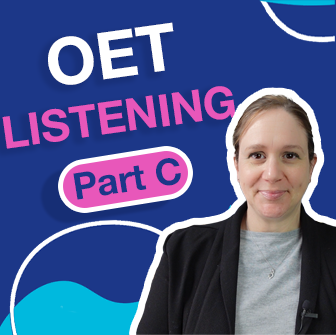
SLC expand online ESOL provision with South East Strategic Partnership for Migration
We’re delighted to have been commissioned to provide an online ESOL programme for refugee and migrant learners by the South East Strategic Partnership for Migration

Listening Part C of the Occupational English Test (OET) assesses your ability to understand extended spoken texts—like interviews, presentations, and discussions—on healthcare topics. These can involve complex language, subtle meaning, and contrasting opinions.
In this article, we break down how to approach Listening C successfully using sample questions and key strategies.
Before the audio begins, take time to:
✅ Notice the context – Is this a formal interview, a presentation, or a podcast?
✅ Read the questions and options carefully – Understand exactly what you’re listening for.
✅ Note the structure – Interviews often follow a sequence (e.g., problem > solution > discussion).
✅ Spot key words and ideas – These will help guide your listening and identify distractors.
For example, in the sample activity, you’re listening to an interview with a doctor discussing vitamin D and the common cold.
Unlike Listening Parts A and B, Part C focuses on attitudes, opinions, and reasoning. You’re not just listening for facts—you’re interpreting meaning.
🎧 In the first question, you’re asked what Dr Riley believes may cause severe upper respiratory infections. The correct answer is B.
Dr Riley says:
“I was curious about other factors that might be involved—such as vitamin D levels, which are lowest in winter when colds are more prevalent.”
This is a subtle way of implying a link between vitamin D deficiency and respiratory infections—and you need to infer this connection.
After choosing your answers, always:
🔁 Listen again with the transcript
🔍 Highlight key phrases that support the correct option
⚠️ Compare with incorrect options and learn how distractors are designed
In the next question, the correct answer is C, which refers to seasonal variation in vitamin D levels. Dr Riley says:
“There’s a real risk of insufficient levels in winter, whereas outside these months people tend to get enough.”
Understanding the logic behind this contrast is essential in Listening C.
📘 Practise with real OET samples involving healthcare presentations or interviews
📘 Always read and analyse the structure of the question and audio
📘 Build your ability to identify paraphrasing and implied meaning
📘 Review language of contrast, uncertainty, suggestion, and opinion
📘 Keep practising with transcripts to learn how examiners structure answers
Practise the sample OET Listening C task and follow along with expert tips.
Includes Listening C sample questions and transcript for in-depth review.
Specialist Language Courses (SLC) are dedicated to helping healthcare professionals excel in the OET. Our expert-led courses focus on the specific language skills and test strategies needed to succeed. With personalised coaching, practice tests, and targeted exercises, we ensure you build the confidence and competence required for each OET sub-test. Join SLC to boost your chances of achieving the scores you need and advancing your healthcare career

We’re delighted to have been commissioned to provide an online ESOL programme for refugee and migrant learners by the South East Strategic Partnership for Migration

We are excited to announce our Black Friday Mega Sale, designed to help healthcare professionals prepare for their exams with high-quality, flexible online learning at

We’re delighted to announce a new partnership between Specialist Language Courses (SLC) and the University of Sharjah’s Clinical & Surgical Training Center (CSTC) — one
Get updates and get the latest materials on Medical English, OET and IELTS
